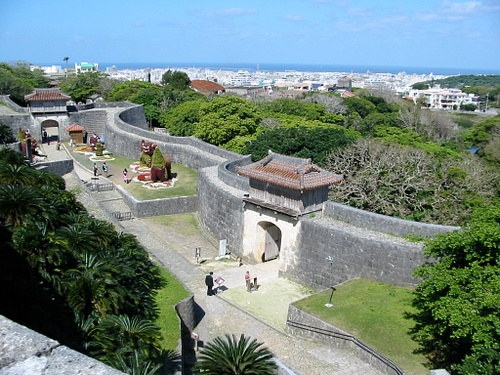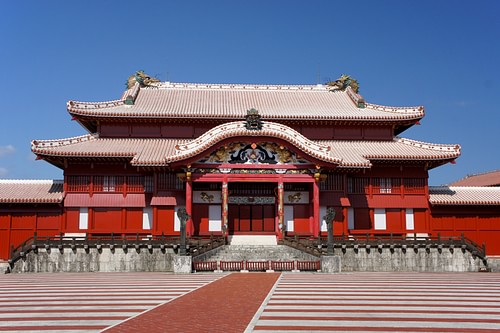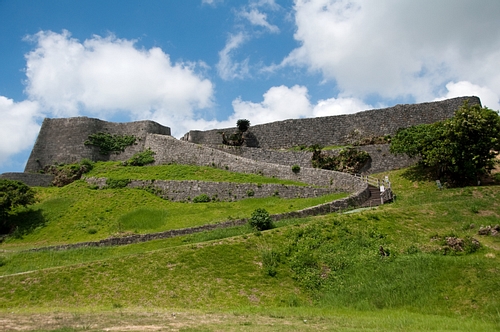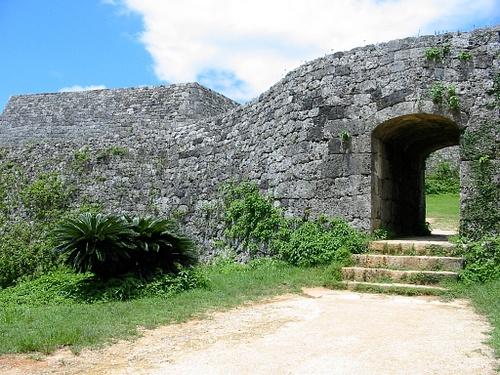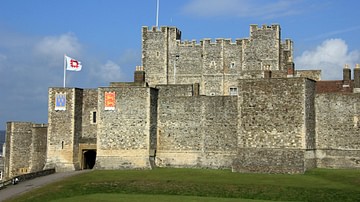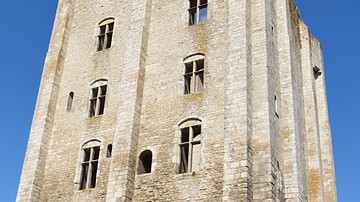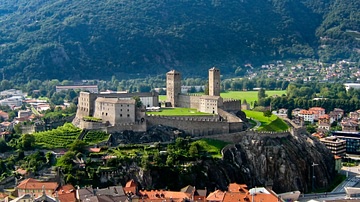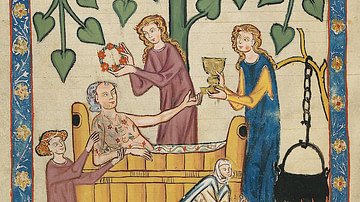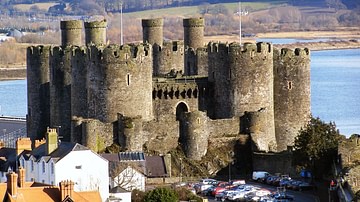The medieval Ryukyu castles on the island of Okinawa, Japan are impressive testimony to the kingdom's power and wealth from the 12th to 16th century CE. Notable castles include Shuri Castle, the royal residence, and four excellent examples of medieval fortresses built in the Okinawa style: Nakijin, Zakimi, Katsuren, and Nakagusuku. Another star attraction is the religious shrine at Seifa Utaki considered the place of creation in Ryukyu mythology. All of these monuments are collectively listed by UNESCO as a World Heritage Site.
The Ryukyu Kingdom
The Ryukyu Islands (Ryukyu Shoto) are an archipelago of around 70 islands located at the very southern end of Japan. The largest island by far is Okinawa and its name is sometimes used to refer to this whole group of subtropical islands. The islanders of Ryukyu were independent for most of their history which goes back some 30,000 years. With genetic and cultural connections to the ancient Jomon and Ainu, the islanders have also regarded themselves as distinct from the Japanese occupying the more northern islands. Even their language, although similar, is different from the Yamato spoken in the rest of Japan. Japan only formally claimed the Ryukyu islands as part of its territory during the Meiji period (1868-1912 CE) when they became the Okinawa Prefecture in 1879 CE. Prior to that, the archipelago enjoyed some seven centuries of independence or semi-autonomy.
The Ryukyu islands had really come together from the 12th century CE when the three main central islands formed a trading unit which thrived on passing trade between Japan, China, Korea, and other parts of Southeast Asia. In this trade, such valuables as copper and swords were exchanged for silk, spices, and ceramics. The three main islands then formed the Sanzan or Three Kingdoms in 1322 CE, which, through the conquest of the other islands in the group, became the Ryukyu Kingdom under Sho Hashi in 1429 CE. It remained part of the Chinese tribute system and exchanged diplomatic missions with the governments of China, Korea, and Japan, maintaining its independence. The islands provided many ships for Japan and one inscribed bell from the period reads: "By sailing our ships, we shall make Okinawa a bridge between countries" (Huffman, 49).
Eventually, as the Japanese military leaders managed to unify Japan, a much greater interest was taken in the distant Ryukyu group. In 1609 CE the islands were forcibly taken over by the Shimazu clan of Satsuma in 1609 CE, an action which was authorised by the Tokugawa Shogunate (1603-1867 CE). Okinawa would once more appear on the international stage, but for all the wrong reasons, with the fierce fighting there in the last year of the Second World War (1939-45 CE) which caused massive loss of life and material destruction. The islands were not formally returned to Japan until 1972 CE.
Shuri Castle
Shuri castle is located just southeast of the city of Naha at the very southern end of Okinawa Island. The castle was built c. 1350 CE and became the royal, political and ceremonial centre of the Ryukyu islands. Built on a natural hill, the castle stands 120 metres (394 ft) above sea level and its buildings display a mix of Chinese and Japanese architectural elements combined with local materials such as limestone and coral.
The limestone fortification walls of the castle are in places an impressive 10 metres (33 ft) high and they stretch for a total length of 1,080 metres (3,543 ft). The main entrance is through the Kankaimon or 'Welcome Gate' which combines limestone with a wooden superstructure. Within the circuit walls are two courtyards, and the inner one has the two-storey Seiden Hall which was used for royal audiences (first floor) and rituals (second floor). Today the second floor contains replicas of the Ryukyu royal throne and crown.
The Seiden is the largest wooden building on the island and is flanked by a separate North and South Hall. The Seiden combines the typical sloping roofs of Japanese architecture with Chinese decorative elements such as dragons and an exterior of bright vermillion lacquer with inlays of gold and mother of pearl. Indeed, the dragon - associated with water in Asian mythology - was especially popular and appears everywhere. It is perhaps no surprise that the medieval maritime lords of Ryukyu adopted the creature as their official symbol.
The nearby Sonohyan Shrine Stone Gate was built in 1519 CE, and it protects a sacred grove (utaki) which is considered to safeguard the most important protective spirit or kang of the castle and the island. Kings would offer a prayer to the spirit whenever they passed the shrine on leaving and returning to the castle.
In the outer grounds of the castle lies the Mausoleum of Tamaudun, which was built in 1501 CE. Safeguarding the remains of 18 Ryukyu kings, their consorts and relations, it is set into the limestone bedrock and has three chambers. The roof has figures of lion-dogs which act as guardians to the mausoleum.
The adjacent Shikinaen Garden, laid out in 1799 CE, and its accompanying villa was once the location of the royal residence of the island after it had moved from Shuri castle itself. The garden has a large pond with a central island reachable from the shore by an arched stone bridge.
Shuri Castle was, unfortunately, destroyed during the Battle of Okinawa in 1945 CE, but an extensive reconstruction programme was carried out, first on the Shikinaen villa from 1975 CE and then the rest of the site from 1992 CE.
Seifa Utaki
Not a castle but an important site on Okinawa is Seifa Utaki, which translates as 'supreme sacred place.' It is located in the southeast of Okinawa, near the town of Chinen, and was the main religious centre of the Ryukyu group. The religion practised in the archipelago, like many other aspects of its culture, was a mix of ideas from Japan, China, and its own heritage. Animism and ancestor worship combined into unique rituals performed at such sites as Seifa Utaki where elements of nature and the landscape were very much a part of the whole experience.
The high priestesses of Seifa Utaki were appointed from 1429 CE and were directly related to the Ryukyu king. The sacred site was only open to women and, once ritually purified, only they could access a rock face which dripped water from stalactites. This water was considered sacred as it sprang from the spot where, in Ryukyu mythology, the gods first stepped foot on Okinawa and then, several generations later, created humans. The water collected by the priestesses was used in rituals and for divination. Many of the ceremonial areas at the site share their names with buildings at Shuri castle.
The 'Gusuku' Fortresses
Of the many 'Gusuku' or Okinawan fortresses that were constructed across the island, four outstanding examples which survive today are Nakijin, Zakimi, Katsuren, and Nakagusuku Castles. Constructed between the 12th and 15th century CE, their impressive walls are a record of both the wealth of the island and the necessity for its people to defend themselves against rival islands within the group and, once the Three Kingdoms had formed in the early 14th century CE, against outsiders. They are also evidence of the very high building skills of the Okinawans as many of the fortification walls of these castles have elegant curves and precisely dressed blocks of limestone. As an extra defensive measure, the walls are often sloping as they rise, making them even more difficult to climb. Gates are seamlessly incorporated into the walls using arches.
The oldest of the four castles is Katsuren, built in the 12th century CE. Perched impressively on a hill, the castle's walls form four enclosures. As at other castles, there are remains of stone shrines or utaki. The most important at Katsuren is a large rounded stone which is thought to be the focal point of worship to the castle's protective kang spirit.
Zakimi castle was built in the 15th century CE and is credited to the efforts of one of the unifying warlords of the Ryukyu kingdom, Gosamaru (d. 1458 CE). Some sections of the outer walls rise to 13 metres (43 ft) in height. The walls were laid out to form two compounds, and they show the typical Okinawan features of arched gateways, curves and well-dressed blocks.
Nakagusuku castle was first built in the 14th century CE and then modified by Gosamaru. Its relative proximity to Katsuren castle to the north is indicative of the great rivalry which existed between the lords of these two castles.
Finally, Nakijin castle, built between the 13th and 15th century CE, is a massive complex covering more than 14 acres. One of its larger compounds may have been used to keep and train horses. The now ruined castle still looms from its hill on the east coast of Okinawa and excavations at the site have revealed fragments of Chinese pottery, illustrating the Ryukyu islands' long and international trading history.
This content was made possible with generous support from the Great Britain Sasakawa Foundation.
